Aarhus is a cozy city with lovely pedestrian streets such as the stretch between the city’s main railroad station and Aarhus Cathedral. The attractions in the same city center area are interesting to see, and there is also access to the beautiful and relatively new city scape along the river Aarhus Å.
Aarhus’s churches are also some interesting places to visit. The city’s cathedral is one of the country’s largest churches, and the neighboring Our Lady exudes medieval character. The contrast from here to the new buildings in the port area of Aarhus is great and perspective-rich as each a contemporary architectural gem.
Aarhus also has a few must visit museums, where some of the well-known ones are the ARoS art museum and the fantastic market town environment from a bygone era in The Old City. The Old City is a unique market town museum with a collection of older houses that have been moved to here, and in addition you can visit places that stand as time capsules, for example, from several periods in the 1900s.
In the vicinity of Aarhus, the sights are also numerous, and there is a great variety of possibilities. Beautiful scenery, old mansions and thrilling amusement parks for children of all ages are just some of the things you can choose to see and do. For the maritime interested, both S/S Hjejlen and the frigate Jutland are internationally unique activities.
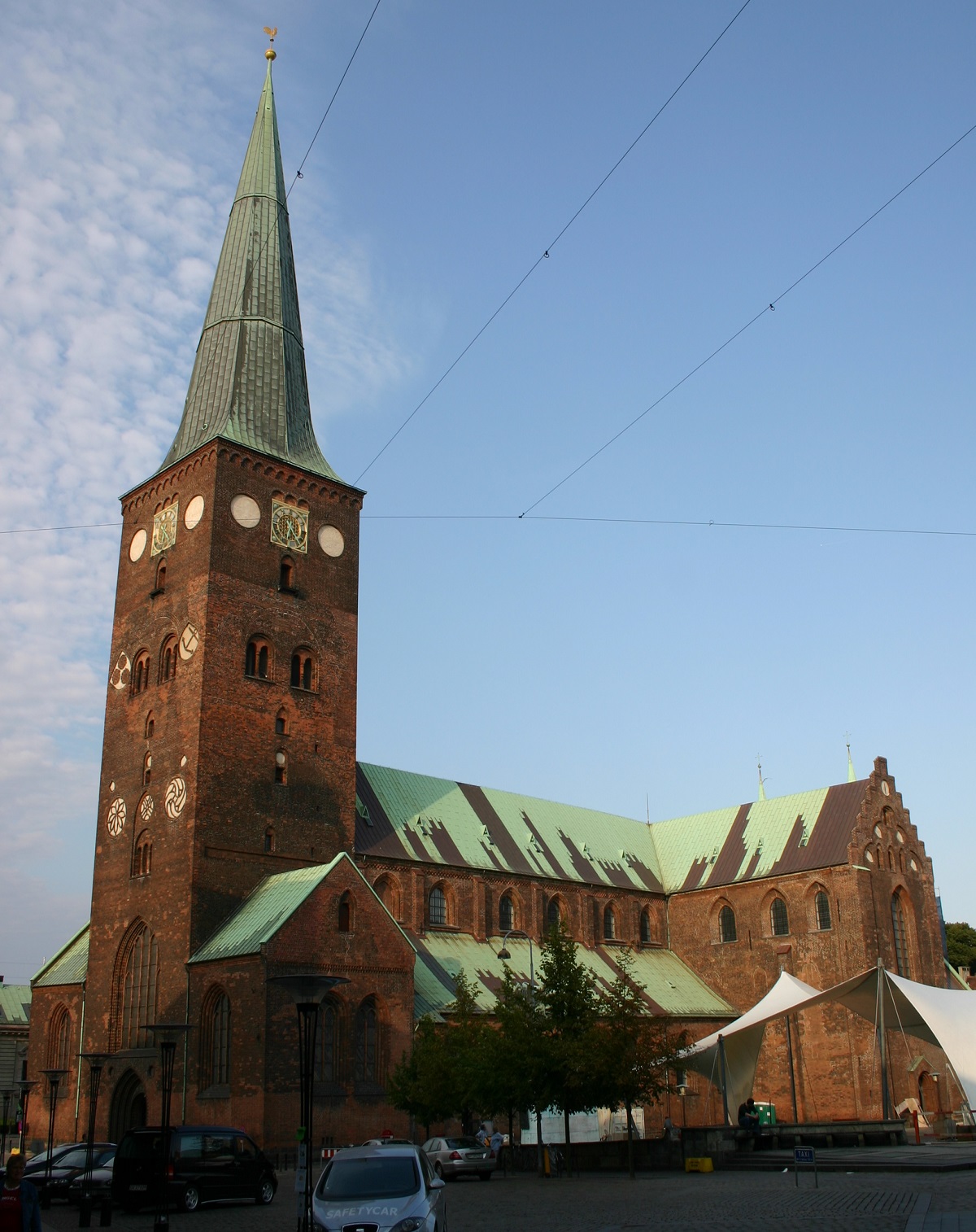
Aarhus Cathedral is the most important church in the Aarhus area. The church building was constructed from around the year 1200 in Romanesque style initiated by Bishop Peder Vognsen. The remains of the Romanesque church, which burned in 1330, can still be seen today in the now Gothic cathedral. The cathedral was expanded until the end of the 1400s.
Aarhus City Hall is the seat of both the City Council of Aarhus and the city administration. At the same time, the town hall is one of Jutland’s most well-known buildings. The town hall was built in the years 1938-1941 by designs from famous Arne Jacobsen and Erik Møller, and since then the building with the 60 meter/197 feet high town hall tower has become the landmark of Aarhus.
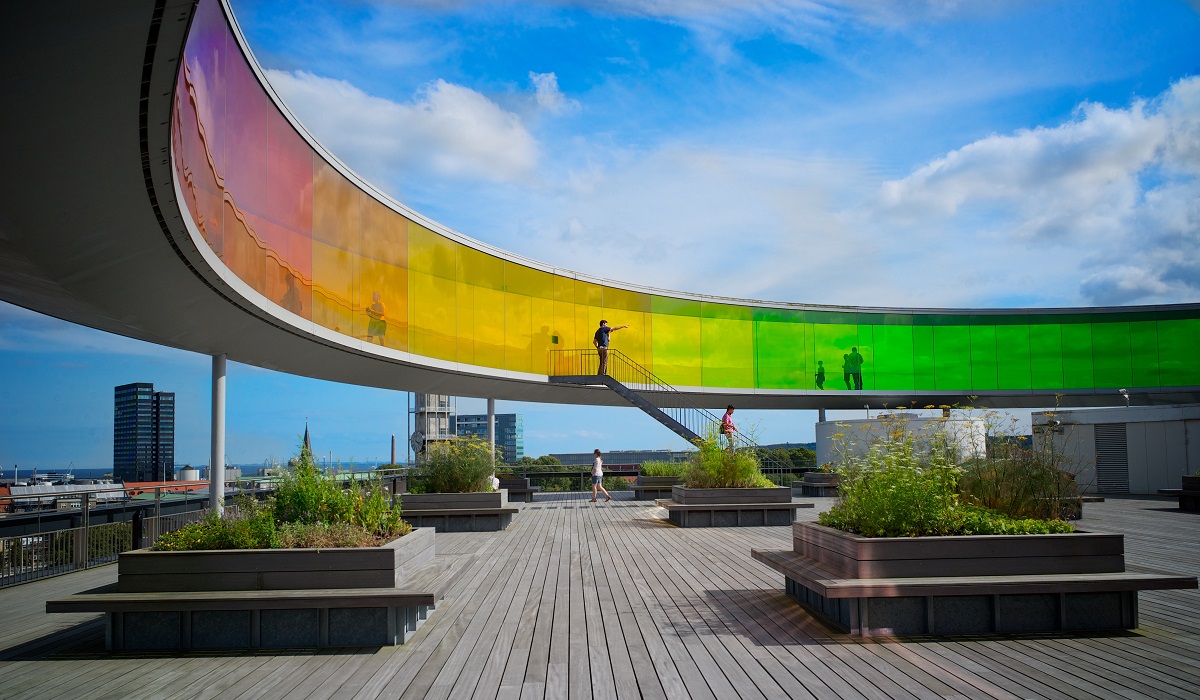
ARoS is Aarhus’ largest art museum and with its well known exhibition building it is also one of the most known in Scandinavia. ARoS opened in 2004 in a modern museum building designed by the architectural firm Schmidt, Hammer & Lassen. The museum is cubist in stone and glass on ten floors with a base of just over 50 × 50 meters/164 x 164 feet. On top is the famous circular walkway in rainbow colors.
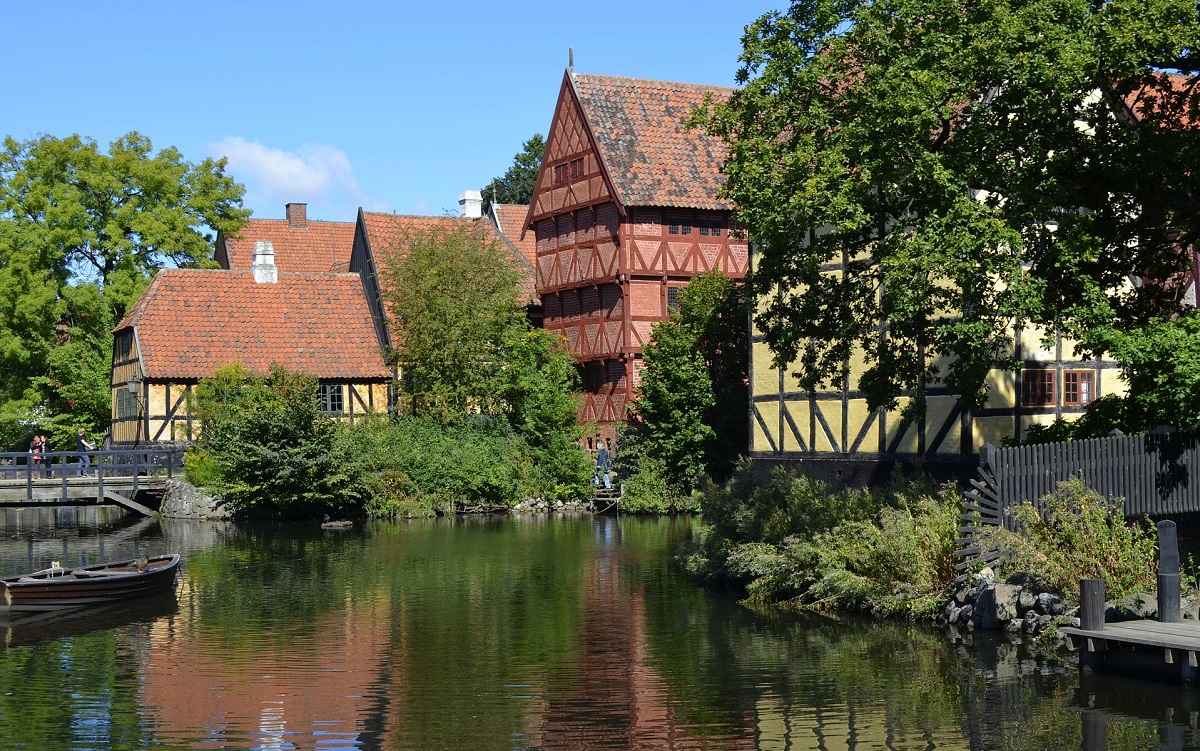
This museum named The Old City was started in 1914 based on the old mayor’s house from Aarhus, which was built in 1909 in connection with a national exhibition, and three other buildings that were moved to the area to be preserved. Today the open air museum has a lot of houses and scenes from daily life in bygone times.
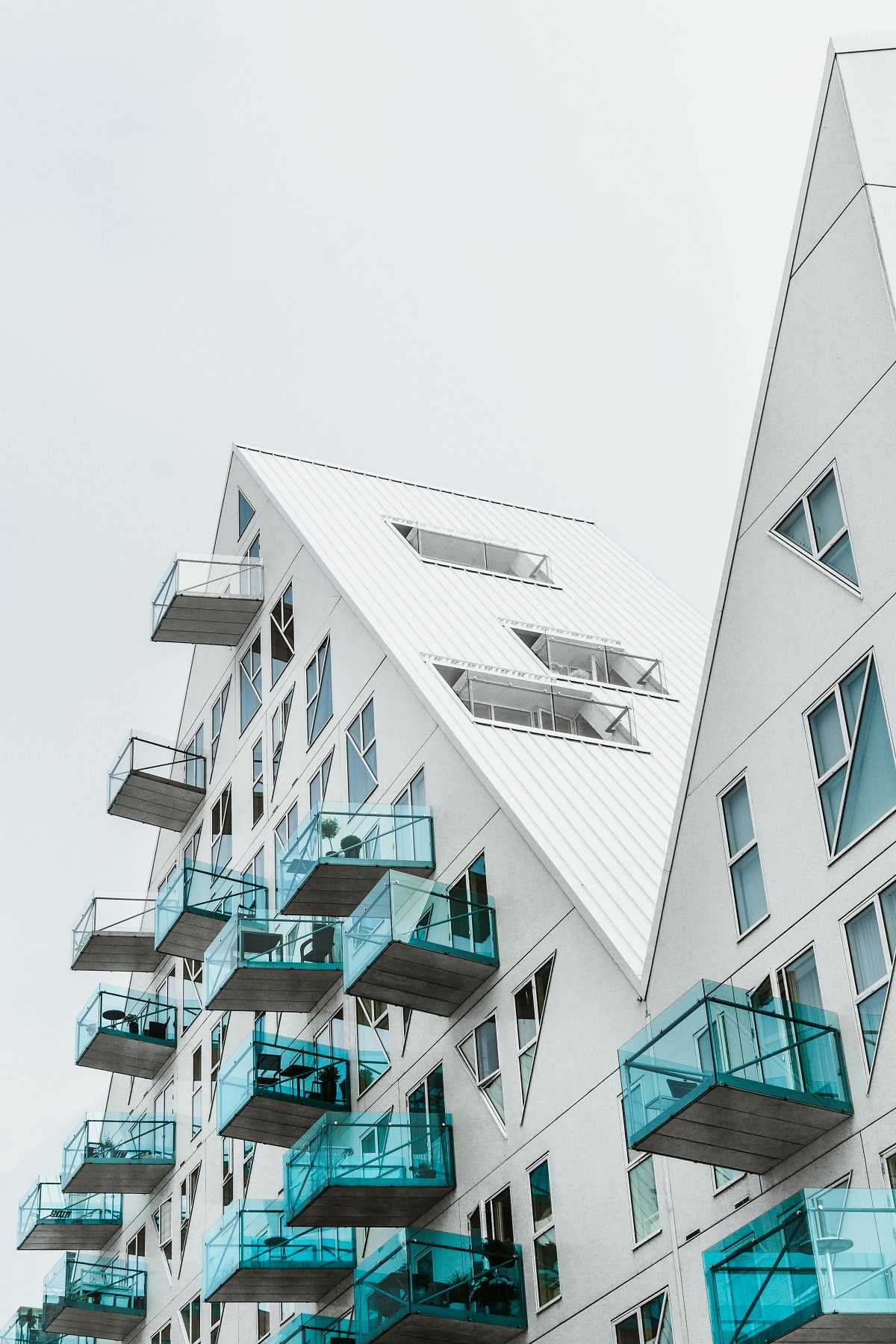
In Aarhus, large areas of former industrial harbor have been developed with architecturally interesting buildings. You can go for a walk and look at, for example, the characteristic white houses called Isbjerget or The Iceberg.
During excavations for the modern bank building at St. Clemens Torv, remains of the city’s old Viking ramparts were found, and they can now be seen at the Viking Museum, which is housed at the site.
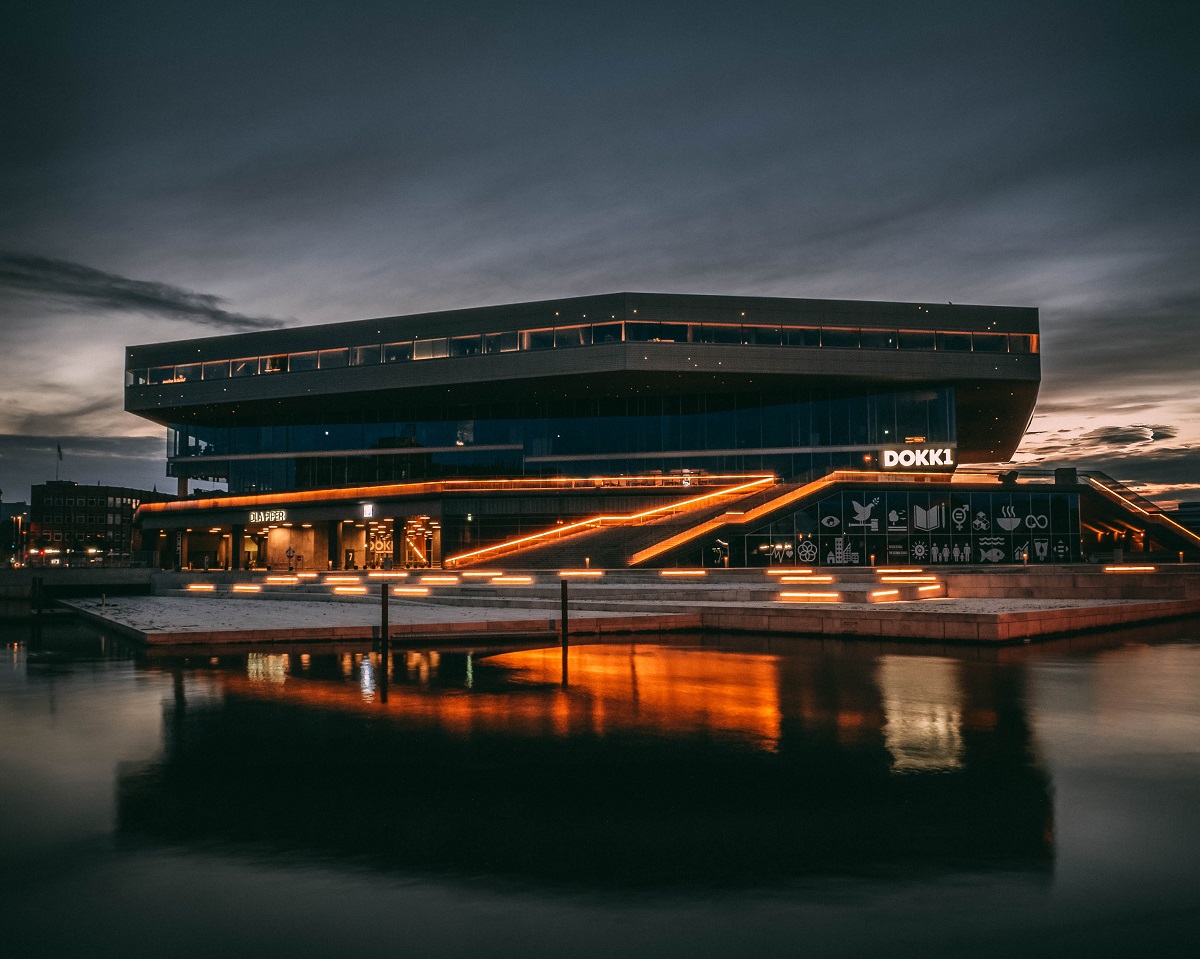
Dokk1 is the name of the Aarhus cultural flagship at the Port of Aarhus. Dokk1 hosts various institutions, which not least include the Aarhus Main Library, municipal services and halls with space for eg theater and concerts.
The two streets Ryesgade and Søndergade together with Sankt Clemens Torv form the central pedestrian street in Aarhus. The streets also go by the name of Strøget and with about 850 meter/2,800 feet it is one of Jutland’s longest shopping streets.
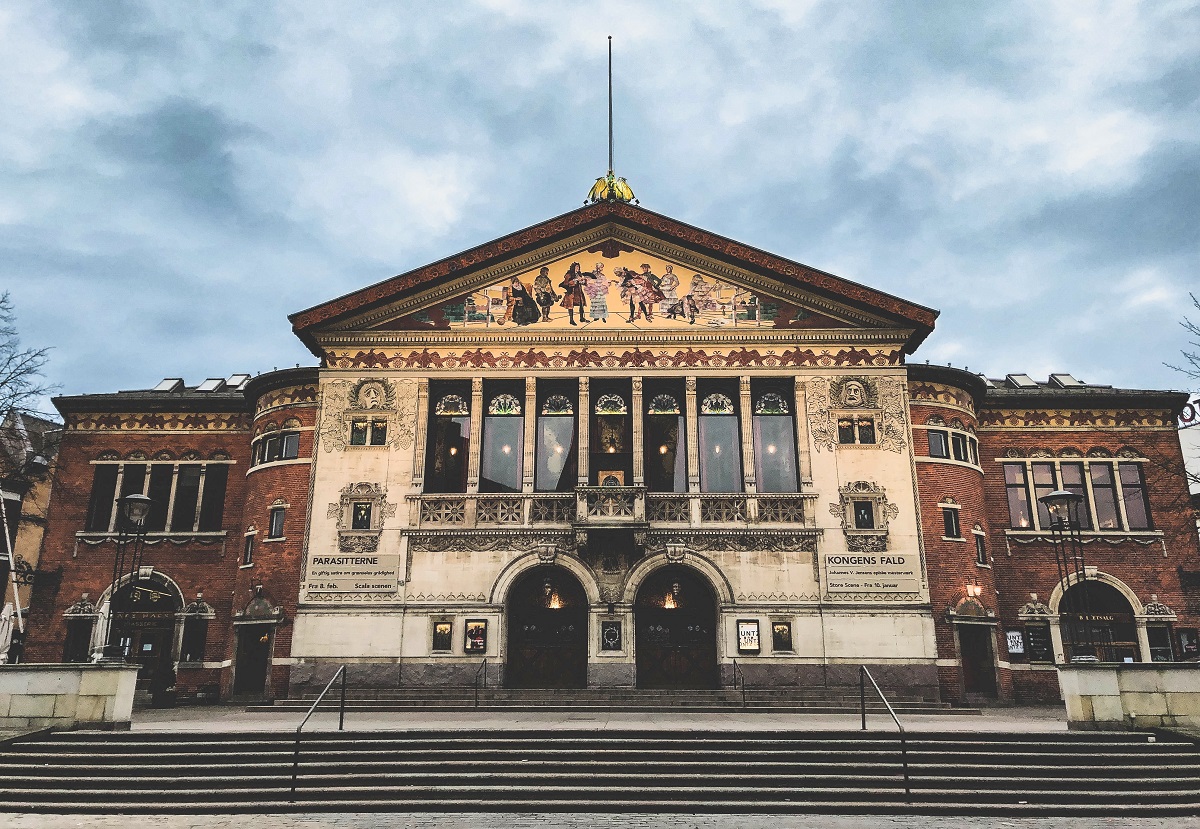
This is the city’s large theater stage. The beautiful building was erected in the 1890s on the initiative of theater-interested citizens, and it was the well-known architect, Hack Kampmann, who designed the theater.
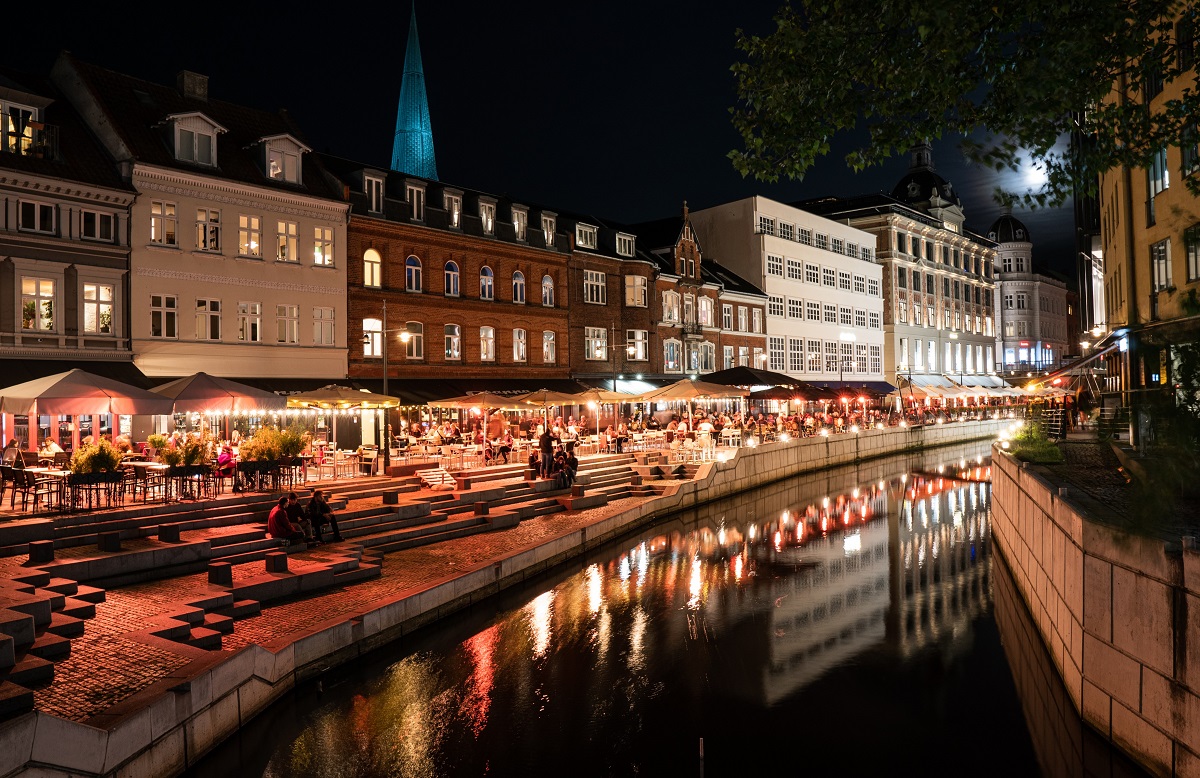
Through the center of Aarhus you can walk along the small river, Aarhus Å, and enjoy the cozy cafes and restaurants located along the street Åboulevarden. You will find a nice outdoor life in the city here.
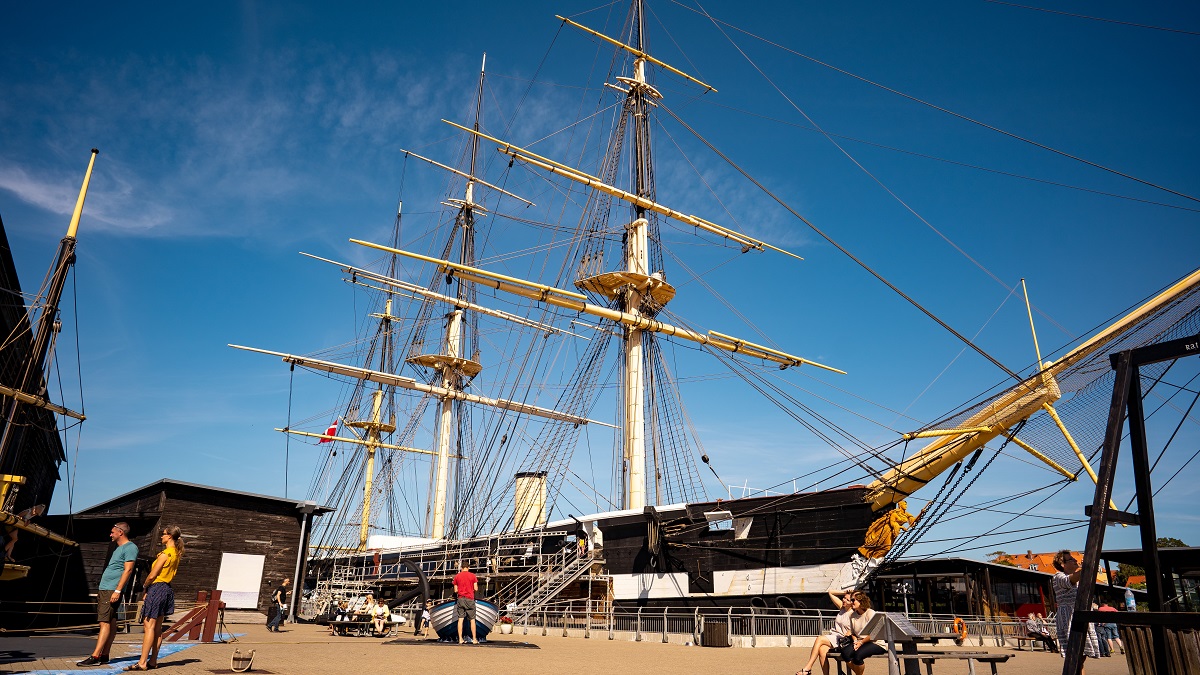
The town of Ebeltoft on Mols is known for its beautiful location and cozy town center, which is one of the region’s most lovely cities. The frigate Jutland is the most known sight. It is a preserved naval ship launched in 1860.
South of Aarhus is the estate Moesgård, whose main building is built in a classicist style from 1780 to 1784. Since 1964, Moesgård has been laid out as a prehistoric museum depicting the ancient times of Denmark and Jutland. Also enjoy the baroque garden, the monument park and a number of older burial mounds.
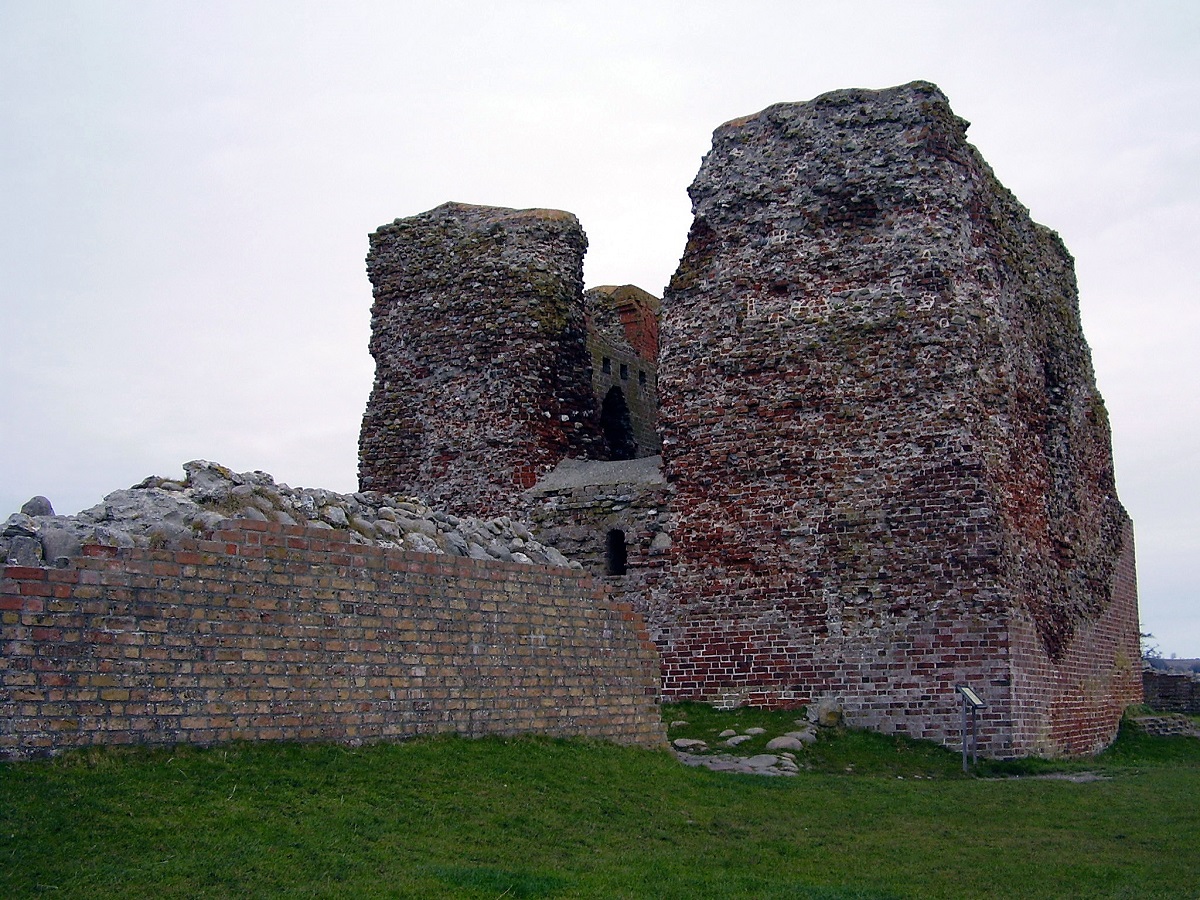
Kalø Castle Ruin is an picturesquely located ruin of the historic Kalø Castle, which was a fortification built by King Erik Menved in 1313. It was one of several facilities made to strengthen the rule of the king after several peasant riots.
Mols Bjerge National Park is a scenic area that was laid out as a national park in 2009. Mols Bjerge is a coastal hillside landscape that offers a number of beautiful hiking trails and activities in the nature.
Himmelbjerget, which means Sky Mountain, is a 147 meter/482 feet high hill, which is beautifully elevated above Julsø, the largest of the Silkeborg Lakes. The lake area can be seen between the cities of Silkeborg and Ry in one of Jutland’s most scenic forestal areas. On the Silkeborg Lakes you can also go on lovely sailing trips with i.a. the paddle steamer Hjejlen from 1861.
MP Bruuns Gade 25
bruunsgalleri.dk
Immervad 2-8
magasin.dk
Søndergade 27
salling.dk
Ryesgade, Søndergade, Frederiksgade, Fiskergade, Åboulevarden, Sct. Clemens Gade, Vestergade
Djurs Sommerland
Randersvej 17, Nimtofte, 45 km NE
djurssommerland.dk
Givskud Zoo
Løveparkvej 3, Givskud, 80 km SW
givskudzoo.dk
Lalandia
Billund, 100 km SW
lalandia.dk
Legoland
Nordmarksvej 9, Billund, 100 km SW
legoland.dk
Naturhistorisk Museum
Wilhelm Meyers Allé 210
naturhistoriskmuseum.dk
Steno Museum
C.F. Møllers Allé 1100
stenomuseet.dk
Tivoli Friheden
Skovbrynet
friheden.dk
The history of Aarhus dates back to the Viking Age and was first mentioned in 948 by Adam of Bremen. Remains of a marketplace from the 8th century, houses and workshops from the 9th century as well as rune stones from around the year 1000 were found. However, there was an actual settlement already in the 7th century, but this one was at Åby at the eastern end of lake Brabrand Sø.
The city was surrounded by urban ramparts and a moat that surrounded the small settlement at the mouth of Aarhus Å in the Bay of Aarhus. Aarhus Å played a significant role for its location as the inner harbor for the city.
Just Aarhus Å was also the important trade route for the first settlement at Brabrand Lake, and the city’s first name, Aros, referred to the new location with the meaning estuary.
Around the year 1200, the current Aarhus Cathedral was started just outside the city’s very old area. The church was founded by Bishop Absalon’s friend Peder Vognsen, who was a bishop in the diocese.
The cathedral building was the starting point for Aarhus’ first major expansion, and right up to the Reformation in 1536, Aarhus Cathedral played a central role in the daily life of the city. Despite various setbacks for the city over the following centuries, not least the monastic monks propelled the city forward.
From the middle of the 13th century several large plants were established in the city. Store Torv and Lille Torv were new central places created during this time, and at Lille Torv a hospital was established.
Around the year 1300 the city flourished, which led to a larger expansion. Here, among other things, the city’s first and thereby oldest town hall was built at the cathedral. Aarhus’ growth in buildings, population and trade continued in the 1400s, and in 1441 the city gained market town rights. That same year, the city received Christoffer from Bavaria as a prominent guest in Aarhus.
In 1477, King Christian I of Aarhus allowed the city to build on the surrounding defense works to ensure the city’s continued expansion. This could be done because the areas had lost their military significance, and thus new streets such as Graven and Volden could be laid out. In the 15th century, the Aarhus Latin Quarter was also established.
After the Reformation in 1536, Aarhus’ larger merchant farms became important factors of power in the city’s government and for its development, which was driven by trade for a long time.
The mid-1500s also became the starting point for a long-term recovery in Aarhus. It lasted until the mid-17th century, which became a period of much foreign penetration into the city. In 1627-1629 the city was attacked by imperial troops, and in 1644 and again in 1657-1659 the Swedes ravaged the region. In addition to the attack, Aarhus was also subject to fire tax.
Despite the assaults and a plague epidemic, Aarhus’s trade developed throughout the 17th century. The primary markets were in addition to Denmark and Norway: Lübeck, Amsterdam, England, France and Spain. The merchant fleet consisted of about 100 ships and the city was at its commercial peak.
In the first half of the 1700s, there was a decline in trade, and economically it went back to Aarhus as in many other Danish cities. The merchant fleet was halved and many of the former trading markets lapsed. By 1769 the population had dropped to about 3,500.
In the early industrialization of Aarhus, small industry and workshops started in the old grocery stores in the Mejlgade neighborhood, already built in the earliest era of Aarhus.
In the 19th century, Aarhus grew, and by 1850 the city had overtaken Randers and Aalborg as Jutland’s largest. It had in a very short time become a big city in Denmark.
The town center extended to the current railway station district, and many imposing town houses and institutions were erected, for example along Søndergade, which over time developed into part of the city’s main street.
In 1847 a major development of the port areas on the Gulf of Aarhus began. The work was completed in 1861, and together with Jutland’s first railway, which opened in 1862 between Aarhus and Randers, helped to strengthen Aarhus as the region’s leading city and the second largest city in the Danish Empire.
Aarhus’s cultural development followed the economic boom, and institutions such as Aarhus Theater were established on the initiative of a group of theater-interested residents. The construction was pompous in relation to the size of the city, which helped to emphasize the city’s leading role.
Throughout the first half of the 1900s, Aarhus continued to develop, and a significant part was the establishment of the University of Aarhus, which with its large academic and geographical area made the city the leader in the country after Copenhagen in the field of education.
Aarhus is still characterized by the active student and research community that developed together with the founding of educational institutions. Today, Aarhus has about 300,000 inhabitants, and it is characterized by a very active business community as the center of Jutland.
The cultural boom that started in the 19th century continued through the 20th century to the present day. The Old Town shopping mall is a unique museum, and with the Music House, the modern art museum, ARoS and the Aarhus Main Library in the newly developed harbor area, the city is well underway. Investments are also being made in Aarhus in other ways, and one of them is the city’s infrastructure with the city’s new and modern light rail, which was inaugurated in 2017.

Overview of Aarhus
Aarhus is a cozy city with lovely pedestrian streets such as the stretch between the city’s main railroad station and the cathedral. The attractions in the same city center area are interesting to see, and there is also access to the beautiful and relatively new city scape along the city river.
The churches are also some interesting places to visit. The city’s cathedral is one of the country’s largest churches, and the neighboring Our Lady exudes medieval character. The contrast from here to the new buildings in the port area is great and perspective-rich as each a contemporary architectural gem.
About the upcoming Aarhus travel guide
About the travel guide
The Aarhus travel guide gives you an overview of the sights and activities of the Danish city. Read about top sights and other sights, and get a tour guide with tour suggestions and detailed descriptions of all the city’s most important churches, monuments, mansions, museums, etc.
Aarhus is waiting for you, and at vamados.com you can also find cheap flights and great deals on hotels for your trip. You just select your travel dates and then you get flight and accommodation suggestions in and around the city.
Read more about Aarhus and Denmark
Buy the travel guide
Click the “Add to Cart” button to purchase the travel guide. After that you will come to the payment, where you enter the purchase and payment information. Upon payment of the travel guide, you will immediately receive a receipt with a link to download your purchase. You can download the travel guide immediately or use the download link in the email later.
Use the travel guide
When you buy the travel guide to Aarhus you get the book online so you can have it on your phone, tablet or computer – and of course you can choose to print it. Use the maps and tour suggestions and you will have a good and content-rich journey.
Aarhus Cathedral • ARoS • Modern Architecture • Old Town Museum

Overview of Aarhus
Aarhus is a cozy city with lovely pedestrian streets such as the stretch between the city’s main railroad station and the cathedral. The attractions in the same city center area are interesting to see, and there is also access to the beautiful and relatively new city scape along the city river.
The churches are also some interesting places to visit. The city’s cathedral is one of the country’s largest churches, and the neighboring Our Lady exudes medieval character. The contrast from here to the new buildings in the port area is great and perspective-rich as each a contemporary architectural gem.
About the upcoming Aarhus travel guide
About the travel guide
The Aarhus travel guide gives you an overview of the sights and activities of the Danish city. Read about top sights and other sights, and get a tour guide with tour suggestions and detailed descriptions of all the city’s most important churches, monuments, mansions, museums, etc.
Aarhus is waiting for you, and at vamados.com you can also find cheap flights and great deals on hotels for your trip. You just select your travel dates and then you get flight and accommodation suggestions in and around the city.
Read more about Aarhus and Denmark
Buy the travel guide
Click the “Add to Cart” button to purchase the travel guide. After that you will come to the payment, where you enter the purchase and payment information. Upon payment of the travel guide, you will immediately receive a receipt with a link to download your purchase. You can download the travel guide immediately or use the download link in the email later.
Use the travel guide
When you buy the travel guide to Aarhus you get the book online so you can have it on your phone, tablet or computer – and of course you can choose to print it. Use the maps and tour suggestions and you will have a good and content-rich journey.

In Aarhus, large areas of former industrial harbor have been developed with architecturally interesting buildings. You can go for a walk and look at, for example, the characteristic white houses called Isbjerget or The Iceberg.
During excavations for the modern bank building at St. Clemens Torv, remains of the city’s old Viking ramparts were found, and they can now be seen at the Viking Museum, which is housed at the site.

Dokk1 is the name of the Aarhus cultural flagship at the Port of Aarhus. Dokk1 hosts various institutions, which not least include the Aarhus Main Library, municipal services and halls with space for eg theater and concerts.
The two streets Ryesgade and Søndergade together with Sankt Clemens Torv form the central pedestrian street in Aarhus. The streets also go by the name of Strøget and with about 850 meter/2,800 feet it is one of Jutland’s longest shopping streets.

This is the city’s large theater stage. The beautiful building was erected in the 1890s on the initiative of theater-interested citizens, and it was the well-known architect, Hack Kampmann, who designed the theater.

Through the center of Aarhus you can walk along the small river, Aarhus Å, and enjoy the cozy cafes and restaurants located along the street Åboulevarden. You will find a nice outdoor life in the city here.
Similar to Aarhus Travel Guide
There are no listings matching your search.
Reset